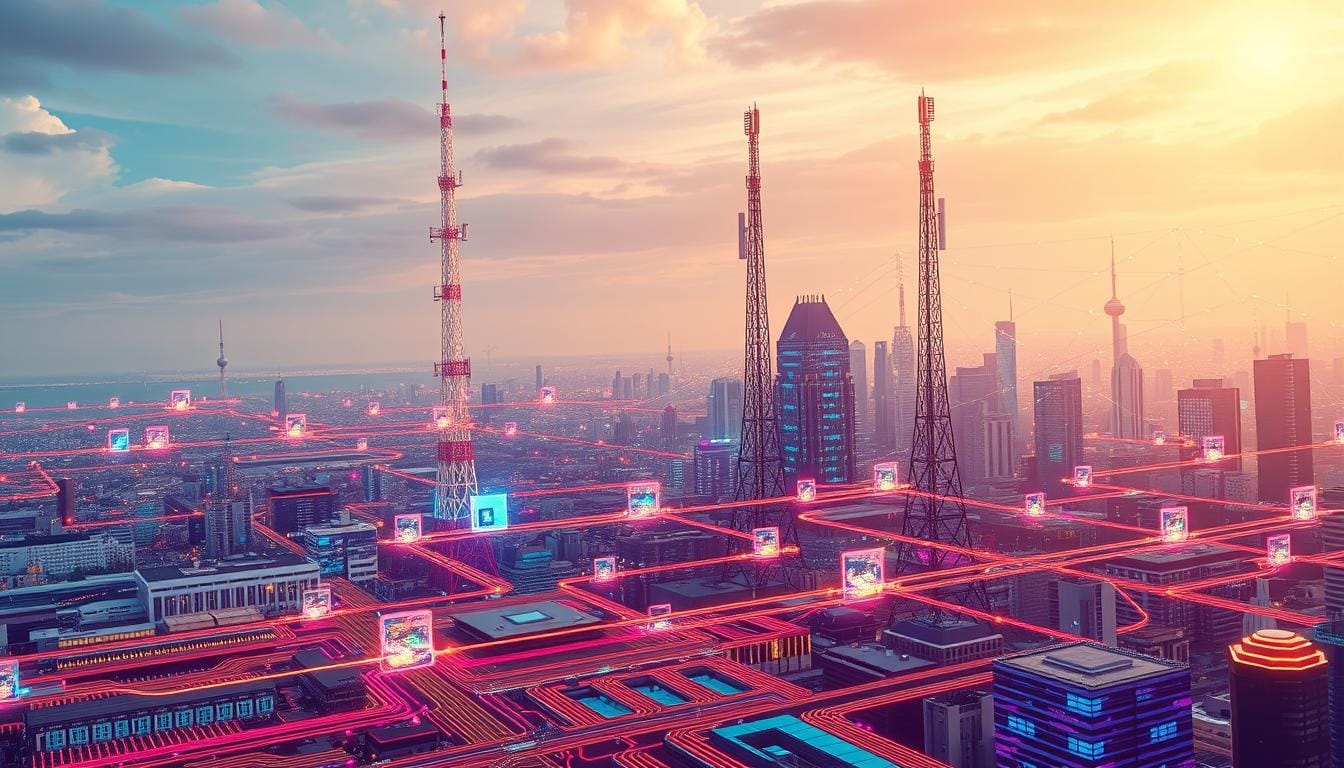Key Takeaways
- 500+ firms co-create 6G standards through 3GPP’s release cycles1.
- 6G’s AI-native design targets 1 Tbps speeds and 1ms latency for edge computing3.
- Global 5G deployment spans 260+ operators, but 50% lack full rollouts2.
- 6G-IA and EU’s €1.8B research fund aim to make 6G a strategic national asset2.
- Open RAN architectures will let 6G support 100x more devices than 5G3.
Understanding 6G Technology and Its Foundations
Wireless communication has come a long way from 1G’s simple voice calls to 5G’s vast IoT networks. Each step has overcome the previous one’s limits, preparing the ground for 6G to change the tech world.
From 1G to 5G: A Brief History of Wireless Technology
1G started with analog systems in the 1980s. Then, 2G brought digital SMS, and 3G introduced mobile internet. 4G enabled HD video streaming, and 5G now offers speeds of 20 Gbps and latency of 1ms4.
These steps have set the stage for 6G’s big leap.
Defining 6G: Technical Parameters and Capabilities
This will enable advanced learning systems and smart campuses. Korean companies like KT Corporation and SK Telecom have already tested 6G with speeds of 100 Gbps6.
Key Differences Between 5G and 6G Networks
6G is set to support trillions of IoT devices and secure networks. It will bring new innovations to education, healthcare, and smart cities.
The Evolution of 6G: What It Means for the Future of Connectivity
,
- ,
- ,
- Quantum encryption mitigates IoT security risks7
- AI-driven spectrum management reduces energy use by 30%3
- Edge computing nodes will process data locally, cutting reliance on centralized servers
| Aspect | 5G | 6G |
|---|---|---|
| Network Coverage | Ground-based towers | Satellites, drones, and ground nodes |
| Latency | 1ms | 0.1ms7 |
| Applications | Smart cities | Global holographic surgery, autonomous drone swarms |
Companies like Nokia and Ericsson (researching for over four years2) are building hybrid networks blending satellites and ground systems. This 3D architecture will power holographic classrooms and remote surgeries, leveraging AI to manage traffic in real-time.
Quantum’s Role in 6G Security
Quantum’s quantum-resistant algorithms will protect critical infrastructure. While 6G’s AI-native design opens new avenues for artificial intelligence assignment help services to explain these advancements to students.
6G’s fusion of space, AI, and quantum tech isn’t just theoretical—Nokia’s testbeds already simulate these systems. The result? A connectivity fabric as seamless as breathing—and as complex as the networks it connects.
Unprecedented Data Speeds and Low Latency
Imagine remote surgeries where a doctor’s hand movements are instantly mirrored by a robot9. It’s faster than a neuron firing.
“6G’s terahertz bands will redefine what’s possible.” — Samsung R&D, 20238
These numbers are key for AI systems. Expert ai assignment support will need 6G’s fast data processing. For example, the upcoming Sora platform—when will sora be available to the public? It’s expected to launch with 6G in 20308.
Its ultra-low latency lets AI handle live data streams. Think self-driving cars reacting to hazards in 0.1ms, not 100ms.
But, speed needs the right infrastructure. Fiber networks and edge computing must grow to handle terabit flows. Quantum encryption9 and AI-driven network management will keep things running smoothly.
The race is on. Huawei, Nokia, and U.S. labs are already testing THz frequencies8. The future is not just faster—it’s smarter, seamless, and closer than you think.
Revolutionary Applications of 6G Technology

The 6G era is more than just faster networks. It’s a step into holographic communication and smart systems that change how we interact. Imagine a doctor’s 3D hologram helping a patient in real time or virtual classrooms where students learn with AI tutors. These ideas use 6G’s high frequencies and ai project help to overcome delays10.
- Holographic Reality – 5G’s 610 billion GDP boost by 203010 shows 6G’s economic impact. But solving AI’s common sense gaps, like recognizing emergencies, requires big breakthroughs11. Universities and tech firms will need professional ai assignment writers to train AI for these challenges.
- Autonomous Ecosystems – Self-driving cars and drones will work together at 10 Gbps speeds, cutting down on accidents by syncing in microseconds10. But, quantum computing advances are key to handling the vast data, delaying full use until after 202811.
- Healthcare 2.0 – Remote robotic surgeries and wearable biosensors could reduce hospital visits. But, the metaverse’s digital twins need sora release date-aligned tech for real-time feedback11.
- Smart Urban Networks – Cities will watch pollution and traffic in real-time, saving energy. The EU’s 6G plans aim to match this with quantum computing goals by 202610.
“The sora release date for full 6G integration hinges on solving AGI’s ‘common sense’ paradox,” says a MIT 6G whitepaper. “Without it, autonomous systems remain reactive, not predictive.”
While 5G’s 0.7% GDP contribution10 hints at 6G’s future, making it happen needs teamwork between hardware experts and AI ethicists. The goal is to link quantum networks with AI that thinks like us, not just processes data. The aim is a world where your commute is guided by algorithms that think like you.
The Technical Challenges of 6G Implementation
6G promises speeds in the terahertz range, but faces big technical hurdles. It needs materials science breakthroughs to handle signal loss from rain or humidity. This is different from 5G’s lower bands9.
Antennas must shrink to millimeter sizes without overheating. This requires new cooling technologies9.
NGMN’s 13 architectural principles stress interoperability with legacy systems to avoid stranded investments12.
The future depends on global R&D partnerships. Companies like Nokia and Ericsson are working on 6G technology chips with graphene-based antennas. Custom AI assignment solutions will help networks adjust during busy times, paving the way for 2030’s connectivity.
Global Race for 6G Dominance: Who's Leading the Charge

The global 6G competition is intense. Governments and tech giants are spending billions on 6g innovations. South Korea’s Samsung launched sora, a next-gen AI network, in 2024, showing early progress13.
Online AI tutoring programs are now training engineers in quantum computing and edge AI. This is helping to fill the skill gaps needed for 6G development14.
United States 6G Initiatives and Research Programs
In the U.S., strategies mix government laws and private research. The CHIPS Act gave $28 billion for 6G and quantum research15. DARPA is testing terahertz spectrum tech.
Qualcomm and Intel are working with the U.S. on IP rights. Universities like MIT, with $35.7 million in grants15, are exploring AI-native network designs.
Asian Market Developments in Next Generation Connectivity
Asia is setting big goals for 6G. China wants to set global standards with its IMT-2030 plan. Japan’s NTT is working with Ericsson on open radio access networks.
South Korea aims to deploy 6G by 2028, using testbeds in Seoul. KDDI is teaming up with Starlink to merge satellite and terrestrial networks with sora, a hybrid platform14.
European Union Strategies for 6G Leadership
The EU is investing €1.8 billion in 6G-IA through Horizon Europe. It’s focusing on AI-driven network security and green tech. The EU is taking an “AI-first” approach, with ethics frameworks to counter other powers.
European telecoms like Ericsson and Nokia are adding AI to 5G infrastructure. This is helping them get ready for 6G faster13.
The 6G race is not just about speed. It’s about shaping the future of digital ecosystems. From AI training to quantum computing trials, talent is as important as technology.
The Economic Impact of 6G Networks
6G’s connectivity advancements are set to change the world economy, leading to trillion-dollar changes in how industries work. Experts predict $1.5 trillion in spending by carriers by 2030—16. This shift will help sectors adapt to ultra-fast, low-latency technology.
Industry Transformation and New Business Models
Manufacturing and healthcare will be at the forefront of this change. NVIDIA’s AI tools, like Genie, make networks more efficient, cutting costs by reducing manual work16. Factories might become fully automated, and the entertainment industry could make money from mixed-reality experiences.
These connectivity advancements rely on AI to optimize RANs16. This will lead to personalized medicine and smart cities.
Job Creation and Workforce Evolution
Automation will replace some jobs, but there will be a big need for AI and quantum computing experts. Training programs, like those using best ai assignment help, will help workers get ready for 6G17. Industries must adjust to 6G’s 10-year development cycle17 and balance ROI with the sora public release timeline‘s economic effects.
Telecom giants face a big challenge: they’ve already spent over $600B on 5G16. They need to see clear returns on their investment. As 6G combines with AI and quantum tech, the economy must evolve to keep up. This is a challenge as big as the opportunities it brings.
Ethical Considerations and Social Implications
As 6G evolves, we face big social and ethical questions. We must balance new tech with fairness, safety, and care for our planet. This will define 6G’s impact on society.

Digital Divide Concerns in the 6G Era
Building 6G needs lots of IoT devices and more towers. This could widen the gap between cities and rural areas. Cities might get ahead, but rural places could be left behind because of high costs7.
Policymakers need to help by funding areas that are left out. The UK is investing £28M in 6G research at universities. This shows how education can lead to fair tech2.
Privacy and Security in an Ultra-Connected World
6G’s fast speeds bring new chances, like holographic calls. But they also bring new risks. With biometric tracking and IoT devices, our privacy could be at risk.
Operators must learn from 5G’s NSA rollout—a “debacle” that failed to deliver network slicing2,
cautions Antlitz, an industry analyst. We need better security for the 1 trillion devices expected by 20307.
Environmental Sustainability of 6G Infrastructure
6G might use more energy than 5G. Each base station could use three times more power. We’re running out of rare minerals like gallium and indium7.
Universities in the EU’s 6G-IA initiative are working on AI to save energy. They aim to reduce waste2. Here’s a comparison:
| Factor | 5G Impact | 6G Solutions |
|---|---|---|
| Energy Use | 2% of global electricity | AI-optimized grids2 |
| Material Demand | Rare earth depletion | Circular economy models |
Without these steps, artificial intelligence in higher education could widen the gap. It could be a chance for fairness or a new problem.
Timeline for 6G Development and Deployment
6G’s journey from lab to reality has a clear roadmap. Research from 2020 to 2024 laid the foundation. Then, from 2024 to 2026, global players like T-Mobile, MITRE, and Cisco worked on AI-native protocols18. By 2028, the first 6G spec was finalized by 3GPP’s Release 21, setting 2030 as the launch date for commercial networks2.
Rollout speeds differ by region. The U.S. and Asia aim for 2030 launches. Europe’s 6G-IA ($1.9B budget) focuses on security and sustainability2. Partnerships like SK Telecom’s AI-native 6G trials are driven by ai project help18. The evolution of 6g faces challenges like spectrum allocation and quantum computing1.
Conclusion: Preparing for the Next Connectivity Revolution
Businesses need to start preparing now. They must update their systems for faster speeds9 and train their teams. It’s important to work together to make sure 6G benefits everyone, not just a few.
The future of 6G is about more than just speed9. It’s about creating networks that help people. The next decade will connect us in ways that open up new opportunities for all.
FAQ
What is 6G, and how does it differ from 5G?
6G is the next step in wireless technology, promising faster speeds and lower latency. It’s designed to work seamlessly with AI, unlike 5G which added AI later. This makes 6G better for many applications.
What are the expected speeds and latencies associated with 6G?
6G is expected to hit speeds of 100 Gbps and have latency under a millisecond. This means it will support fast applications like holographic communication and AI help.
How will 6G impact industries like higher education?
6G will change education with AI-powered learning environments. It will improve tools like AI homework help and create new ways to learn.
What are the major technical challenges facing 6G development?
Developing 6G faces big challenges. These include working in high frequency bands, dealing with signal loss, and designing efficient antennas. Also, creating strong security against quantum threats is a big task.
What is the geopolitical landscape for 6G development?
Countries like the US, China, Japan, and South Korea are racing to lead in 6G. They’re investing heavily and working on standards to stay ahead.
How does AI play a role in 6G?
AI is key in 6G for managing networks and resources. It will also power new applications in health care and education, including AI homework help.
What are the economic implications of 6G networks?
6G will change industries with new business models and services. It will also require workers with advanced skills, impacting jobs and training.
What ethical concerns arise with the deployment of 6G?
As 6G grows, concerns like the digital divide and privacy issues will rise. The environmental impact of its infrastructure is also a big concern.
What is the timeline for 6G deployment?
The plan for 6G includes research from 2020-2024 and testing by 2028. Commercial use is expected from 2030-2031, showing a clear path forward.
When will Sora be available to the public?
Sora, a tool for homework and project help, is being developed. Its release date is not set yet. Updates on its launch will be important for those interested in AI education tools.
Source Links
- https://www.fiercewireless.com/sponsored/global-technology-standards-shaping-future-5g-advanced-and-6g – Global Technology Standards: Shaping the Future of 5G Advanced and 6G
- https://www.datacenterdynamics.com/en/analysis/the-6g-future-must-learn-from-5gs-shortcomings/ – The 6G future must learn from 5G’s shortcomings
- https://www.boozallen.com/insights/ai-research/booz-allen-and-nvidia-shape-the-ai-powered-6g-future.html – Booz Allen and NVIDIA Shape the AI Powered 6G Future
- https://www.cablelabs.com/blog/mobile-technologies-6g-era – Up Next in Mobile Connectivity: The Technologies That Will Usher in 6G
- https://cioinfluence.com/networking/the-role-of-6g-in-data-center-connectivity-preparing-for-an-ultra-low-latency-future/ – The Role of 6G in Data Center Connectivity
- https://www.eurekalert.org/news-releases/1076217 – ETRI develops core network technology for 6G hyper-immersive services
- https://www.lifecycle-software.com/resources/the-future-of-connectivity-what-will-6g-bring-to-our-world – The Future of Connectivity: What will 6G bring to our world?
- https://www.7thglobal5gevent.eu/what-is-6g-a-sneak-peek-into-the-future-of-wireless-networks/ – What is 6G? A Sneak Peek Into the Future of Wireless Networks – 5G & Beyond
- https://fpgainsights.com/test-measurement/emerging-trends-in-6g-testing/ – Emerging Trends in 6G Testing – Preparing for the Future of Communication
- https://www.telecomreview.com/articles/reports-and-coverage/8960-5g-advanced-setting-the-stage-for-the-6g-revolution – 5G-Advanced: Setting the Stage for the 6G Revolution
- https://news.vt.edu/articles/2025/01/eng-coe-ece-beyond-6G-common-sense.html – Virginia Tech researchers publish revolutionary blueprint to fuse wireless technologies and AI
- https://www.rcrwireless.com/20250220/featured/ngmn-evolution-towards-6g – NGMN unveils key principles for the evolution towards 6G
- https://www.yahoo.com/tech/key-faster-6g-speeds-lies-120000783.html – Key to faster 6G speeds lies in letting new AI architecture take control, scientists say
- https://www.nbcbayarea.com/news/business/money-report/telcos-race-to-transition-from-dumb-pipes-to-tech-players-with-help-from-ai/3820561/?os=a[0]&ref=app – Telcos race to transition from ‘dumb pipes’ to tech players with help from AI
- https://www.comsoc.org/publications/ctn/pipes-intelligent-service-pipes-generational-telco-evolution-ai-could-make-reality – From Pipes to Intelligent Service Pipes, the Generational Telco Evolution That AI Could Make Reality
- https://www.cryptoninjas.net/news/nvidia-debuts-new-ai-tools-for-next-generation-6g-wireless-networks/ – NVIDIA Debuts New AI Tools for Next Generation 6G Wireless Networks
- https://link.springer.com/article/10.1007/s43926-025-00123-7 – A comprehensive survey on 6G-security: physical connection and service layers – Discover Internet of Things
- https://nvidianews.nvidia.com/news/nvidia-and-telecom-industry-leaders-to-develop-ai-native-wireless-networks-for-6g – NVIDIA and Telecom Industry Leaders to Develop AI-Native Wireless Networks for 6G
- https://techstory.in/how-6g-will-change-the-internet-experience/ – How 6G Will Change the Internet Experience





